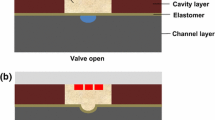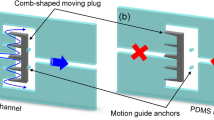Abstract
A phase change (PC) microvalve with an integrated two-level cooling/heating system is developed for microfluidic applications in this article. This PC microvalve utilizes the liquid–solid PC of a small portion of the working medium in a microchannel to switch on/off the flow in the microchannel. The size of the working medium for the PC microvalve is 5-mm long, 50-μm high, and 80-μm wide (50 μm × 80 μm is the cross-sectional area of the channel) in this study. The switch is actuated by using a two-level cooling/heating system integrated on the chip. The first-level cooling/heating unit keeps the working medium in the valve area in the temperature range of supercooling state. Based on the supercooling state, the second-level cooling/heating unit either heats up or cools down the medium in the valve area to trigger its PC between liquid and solid for valving purposes. The proposed microfluidic PC microvalve is characterized experimentally in microfluidic chips. The thermal impact of one PC microvalve in one particular microchannel on its adjacent channels is discussed by establishing a preliminary analytical model and a numerical model. In addition to no leakage and no moving element, this PC microvalve with a two-level cooling/heating system can achieve a very short cooling time (i.e., 2.72 s).








Similar content being viewed by others
References
Al-Gailani BRM, Greenway GM, McCreedy T (2007) A miniaturized flow-injection analysis (μFIA) system with on-line chemiluminescence detection for the determination of iron in estuarine water. International Int J Environ Anal Chem 87:637–646
Andersson H, Berg A (2003) Microfluidic devices for cellomics: a review. Sens Actuators B 92:315–325
Baldi A, Gu Y, Loftness PE, Siegel RA, Ziaie B (2003) A hydrogel-actuated environmentally sensitive microvalve for active flow control. J Microelectromech Syst 12:613–621
Beebe DJ, Moore JS, Bauer JM, Yu Q, Liu RH, Devadoss C, Jo BH (2000) “Functional structures for autonomous flow control inside micro fluidic channels. Nature 404:588–590
Bevan CD, Mutton IM (1995a) Use of freeze-thaw flow management for controlling and switching fluid flow in capillary tubes. Anal Chem 67:1470–1473
Bevan CD, Mutton IM (1995b) Freeze-thaw flow management: a novel concept for high-performance liquid chromatography, capillary electrophoresis, electrochromatography and associated techniques. J Chromatogr A 697:541–548
Borowsky JF, Giordano BC, Lu Q (2008) Electroosmotic flow-based pump for liquid chromatography on a planar microchip. Anal Chem 80:8287–8292
Carlen ET, Mastrangelo CH (2000) Paraffin actuated surface micromachined valves. Microelectro mechanical system, MEMS 2000. The thirteenth annual international conference, p 381
Chen Z, Wang J, Qian S, Bau HH (2005) Thermally-actuated, phase change flow control for microfluidic systems. Lab Chip 5:1277–1285
Eddington DT, Beebe DJ (2004) A valved responsive hydrogel microdispensing device with integrated pressure source. J Microelectromech Syst 13:586–593
Gui L, Liu J (2004) Ice valve for a mini/micro flow channel. J Micromech Microeng 14:242–246
He Y, Zhang YH, Yeung ES (2001) Capillary-based fully integrated and automated system for nanoliter polymerase chain reaction analysis directly from cheek cells. J Chromatogr A 924:271–284
Kays WM, Crawford ME, Weigand B (2004) Convective heat and mass transfer, 4th edn. McGraw-Hill, New York
Kim SM, Lee SH, Suh KY (2008) Cell research with physically modified microfluidic channels: A review. Lab Chip 8:1015–1023
Liu RH, Yang J, Lenigk R, Bonanno J, Grodzinski P (2004b) Single-use, thermally actuated paraffin valves for microfluidic applications. Sens Actuators B 98:328–336
Liu RH, Yang J, Lenigk R, Bonanno J, Grodzinski P (2004a) Self-contained, fully integrated biochip for sample preparation, polymerase chain reaction amplification, and DNA microarray detection. Anal Chem 76:1824–1831
Oh KW, Ahn CH (2006) A review of microvalve. J Micromech Microeng 16:R13–R39
Ozisik MN (1980) Heat conduction, 1st edn. Wiley, New York
Pal R, Yang M, Johnson BN, Burke DT, Burns MA (2004) Phase change microvalve for integrated devices. Anal Chem 76:3740–3748
Richter A, Kuckling D, Howitz S, Gehring T, Arndt KF (2003) Electronically controllable microvalves based on smart hydrogels: magnitudes and potential applications. J Microelectromech Syst 12:748–753
Richter A, Howitz S, Kuckling D, Arndt KF (2004) Influence of phenomena of volume phase transition at the behavior of hydrogel based valves. Sens Actuators B 99:451–458
Shaikh KA, Li S, Liu C (2008) Development of a latchable microvalve employing a low-melting-yemperature metal alloy. J Microelectromech Syst 17:1195–1203
Sia SK, Whitesides GM (2003) Microfluidic devices based on poly(dimethylsiloxane) for biological studies. Electrophoresis 24:3563–3576
Stan CA, Schneider GF, Shevkoplyas SS, Hashimoto M, Ibanescu M, Wiley BJ, Whitesides GM (2009) A microfluidic apparatus for the study of ice nucleation in supercooled water drops. Lab Chip 9:2293–2305
Suarez G, Jin YH, Auerswald J, Berchtold S, Knapp HF, Diserens JM, Leterrier Y, Manson AE, Voirin G (2009) Lab-on-a-chip for multiplexed biosensing of residual antibiotics in milk. Lab Chip 9:1625–1630
Tan H, Yeung ES (1998) Automation and integration of multiplexed on-line sample preparation with capillary electrophoresis for high-throughput DNA sequencing. Anal Chem 70:4044–4053
Welle RP, Hardy BS (2005) Peltier-actuated microvalve performance optimization. Proceedings of the 24th international conference on thermoelectrics, pp 328–331
Yang B, Lin Q (2009) A latchable phase-change microvalve with integrated heaters. J Microelectromech Syst 18:860–867
Yu C, Mutlu S, Selvaganapathy P, Mastrangelo CH, Svec F, Frechet JMJ (2003) Flow control valves for analytical microfluidic chips without mechanical parts based on thermally responsive monolithic polymers. Anal Chem 75:1958–1961
Acknowledgments
The authors gratefully acknowledge the support of Natural Sciences and Engineering Research Council (NSERC) of Canada through a grant to Carolyn L. Ren and Ontario Ministry of Research and Innovation through the Early Research Award to Carolyn L. Ren.
Author information
Authors and Affiliations
Corresponding author
Rights and permissions
About this article
Cite this article
Gui, L., Yu, B.Y., Ren, C.L. et al. Microfluidic phase change valve with a two-level cooling/heating system. Microfluid Nanofluid 10, 435–445 (2011). https://doi.org/10.1007/s10404-010-0683-3
Received:
Accepted:
Published:
Issue Date:
DOI: https://doi.org/10.1007/s10404-010-0683-3




